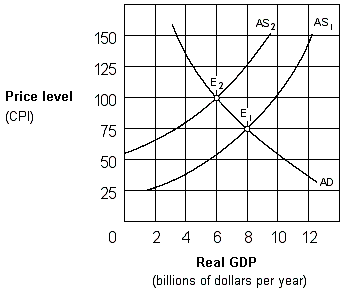Multiple Choice
Exhibit 14-2 Aggregate supply and demand curves
In Exhibit 14-2, the change in equilibrium from E1 to E2 represents:
A) cost-push inflation.
B) demand-pull inflation.
C) price-push inflation.
D) wage-push inflation.
Correct Answer:

Verified
Correct Answer:
Verified
Q10: Exhibit 14-1 Aggregate supply curve<br><img src="https://d2lvgg3v3hfg70.cloudfront.net/TBX9288/.jpg" alt="Exhibit
Q12: For an economy, aggregate demand equals:<br>A) consumption
Q17: When moving along a market demand curve,
Q21: Along the Keynesian range of the aggregate
Q46: Suppose the price level falls. The result
Q50: Which of the following events is the
Q54: Which of the following would shift the
Q70: Which of the following could not be
Q77: Which of the following will most likely
Q91: In the intermediate range of the aggregate